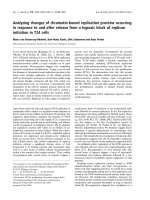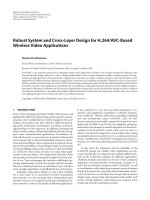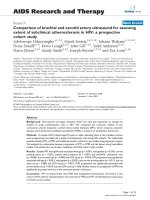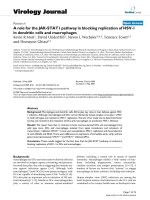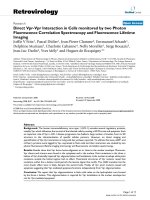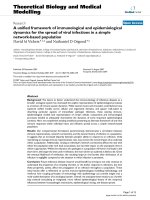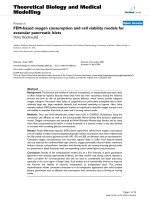Light sheet based fluorescence correlation and cross correlation spectroscopy for quantitative measurements of bio molecules in live cells
Bạn đang xem bản rút gọn của tài liệu. Xem và tải ngay bản đầy đủ của tài liệu tại đây (6.71 MB, 135 trang )
LIGHT SHEET BASED FLUORESCENCE
CORRELATION AND
CROSS-CORRELATION SPECTROSCOPY
FOR QUANTITATIVE MEASUREMENTS OF
BIO-MOLECULES IN LIVE CELLS
ANAND PRATAP SINGH
A THESIS SUBMITTED FOR
THE DEGREE OF DOCTOR OF PHILOSOPHY
DEPARTMENT OF CHEMISTRY
NATIONAL UNIVERSITY OF SINGAPORE
2014
LIGHT SHEET BASED FLUORESCENCE
CORRELATION AND CROSS-CORRELATION
SPECTROSCOPY FOR QUANTITATIVE
MEASUREMENTS OF BIO-MOLECULES IN LIVE
CELLS
ANAND PRATAP SINGH
(M.Sc Chemistry, BHU, INDIA)
NATIONAL UNIVERSITY OF SINGAPORE
2014
This page intentionally left blank
Declaration
The work for this thesis was conducted under a collaboration between Assoc.
Prof. Dr. Thorsten Wohland, NUS, Singapore and Prof. Dr. Jörg Langowski,
DKFZ, Germany. All the research work has been performed at CBIS NUS, un-
less its mentioned. I have duly acknowledged all the sources of information
which have been used in the thesis. This thesis has also not been submitted for
any degree in any university previously.
Anand Pratap Singh
Signature
The results have been partially published in
1- Anand Pratap Singh
†
, Jan Wolfgang Krieger
†
, Jan Buchholz, Edoardo
Charbon, Jörg Langowski, and Thorsten Wohland; The Performance of
2D Array Detectors for Light Sheet Based Fluorescence Correlation
Spectroscopy, Opt. Express. 2013.
2- Jan Wolfgang Krieger
†
, Anand Pratap Singh
†
, Christoph S. Garbe, Thorsten
Wohland, and Jörg Langowski; Dual-Color Fluorescence Cross-Correlation
Spectroscopy on a Single Plane Illumination Microscope (SPIM-FCCS),
Opt. Express. 2014.
3- Anand Pratap Singh and Thorsten Wohland; Applications of Imaging
FCS, Curr. Opin. Chem. Biol., 2014.
†
A. P. Singh and J. W. Krieger contributed equally to this work.
iv
Acknowledgements
Foremost and above all, my sincerest gratitude to my Ph.D supervisor Assoc.
Prof. Dr. Thorsten Wohland for his constant support, patience, and encourage-
ment to make this thesis successful. Although I had my training in experimental
physical chemistry, his constant thoughtful ideas improved my understanding of
optics and microscope building. It is a great pleasure and experience to work
with you and your team. I really appreciate, your positive attitude towards stu-
dents and academic profession.
Besides my supervisor, I would like to thanks Prof. Dr. Jörg Langowski for
his constant support, valuable discussions, and thanks for hosting me for two
weeks lab visit, it was a great experience to meet your lab members. I would
also like to thank Dr. Katalin Tóth for her help during my DKFZ visit.
I am particularly grateful for the assistance by Jan Krieger. I enjoyed and
learned by all long conversation on building microscope, discussions on mea-
surements and thanks for arranging everything during DKFZ trip. I thank Ms.
Agata Pernus for sharing protocols and the discussions on cell measurements.
I thank Dipanjan Bhattachrya for helpful discussions and support during the
last four years.
All TW lab members Ma Xiaoxiao, Wang Xi, Nirmalya Bag, Sun Guangyu,
Angela Koh, Huang Shuangru, Sibel Yavas, Andreas Karampatzakis, Shi Hua
Teo, Shiying Lim, Patrick Kramer, Kaijie Herbert Fan, and Kumaravel Kandaswamy
for their critical comments, support and fun time throughout the last four year. I
also thank to my senior lab members, Jagadish Sankaran for imaging FCS data
fitting, Foo Yong Hwee for teaching confocal FCS, and Tapan Kumar Mistiri for
teaching me cell culture. Radek Machá
ˇ
n for his lunch time chat on interesting
v
scientific, social and cultural issues, I really enjoy it. And special thanks to SPIM
users Antonija, Adam, Angela, Xuewen, Andreas, and Kumar.
I would like to acknowledge financial, academic and technical support from
department of chemistry and center for bio-imaging sciences, particularly Madam
Suriawati Bte Sa’Ad for all official matters. This graduate study would not have
been possible without the NUS Graduate Fellowship during last four years.
I would like to thank for all supports from Hamamatsu Photonics, Keybond
technology for loan of ORCA-Flash4.0and Dynamic Analysis System Pte Ltd,
Singapore for loan of SA-05commercial CMOS.
I thank Prof. Dr. Sudipta Maiti, Dr. Ming Cherk Lee, Dr. A S Rama Koti,
Dr. Jyotishman Dasgupta, Dr. Biswajit Maiti and my school teacher Ronald
Rodrigues, they all have been a wonderful teacher and mentor at different levels
of my academic career, thanks a lot for your constant help and support.
To all my friends, Ajay, Anuradha, Debanjan, Jasmine, Kuldeep, Rahul, Subha,
Veer Bhadur, Zubair and many more for their company and great fun together.
This would not have been possible without your love, support, and friendship.
You guys are simply awesome!
Last but not least, I would like to thank my family members; my parents, sis-
ters and brother for their all constant support, love and encouragement through-
out my life.
vi
Abstract
Cellular processes occur over a wide range of spatial ( nm - mm) and temporal
scales ( µs - min). However, most microscopy methods do not provide sufficient
spatio-temporal resolution to cover this range. Therefore, I introduce here the
combination of light sheet microscopy (single plane illumination microscopy -
SPIM) and fluorescence correlation and cross-correlation spectroscopy (FCS
and FCCS). SPIM-FCS/SPIM-FCCS allows measuring concentration, diffusion,
transport, and interactions maps in a true imaging mode with single molecule
sensitivity. The method provides diffraction limited spatial resolution with sub-
ms temporal resolution which is sufficient to quantify the dynamics of membrane,
cytosolic and nuclear proteins in living cells and organisms. In this work I provide
guidelines on the building and characterization of microscope setups, on the
suitability of different cameras, on sample preparation and mounting and on
the data analysis of this novel imaging FCS and FCCS methods and present
applications to demonstrate its suitability for biophysical and biomedical studies.
vii
This page intentionally left blank
Contents
Declaration iv
Acknowledgements v
Abstract vii
List of Tables xii
List of Figures xiii
List of Abbreviations and Symbols xv
1 Introduction and Outline 1
2 Fluorescence Correlation Spectroscopy: FCS 8
2.1 Introduction and Historical Background . . . . . . . . . . . . . . 8
2.2 FCS: A Tool to Measure Dynamics and Concentrations. . . . . . 11
2.3 Principles and Theoretical Background . . . . . . . . . . . . . . . 11
2.3.1 Diffusion coefficient and concentration . . . . . . . . . . . 18
2.3.2 FCS experimental setup . . . . . . . . . . . . . . . . . . 20
2.4 FCCS: A Measure of Bio-Molecular Interaction . . . . . . . . . . 21
2.5 Principles and Theoretical Aspects of FCCS . . . . . . . . . . . . 22
2.5.1 Spectral cross-talk corrected Autocorrelation and Cross-
Correlation Functions . . . . . . . . . . . . . . . . . . . . 26
2.5.2 FCCS experimental setup . . . . . . . . . . . . . . . . . . 28
3 Single Plane Illumination Microscopy: SPIM 30
3.1 The Past and Present of Light-Sheet Microscopy . . . . . . . . . 30
3.2 Illumination Schemes . . . . . . . . . . . . . . . . . . . . . . . . 32
3.3 Light-Sheet Generation . . . . . . . . . . . . . . . . . . . . . . . 34
ix
3.3.1 GRIN lens: Objective-coupled planar illumination microscopy
(OCPI) . . . . . . . . . . . . . . . . . . . . . . . . . . . . 34
3.3.2 Cylindrical lens: Ultramicroscopy and SPIM . . . . . . . . 35
3.3.3 Digital scanned laser light-sheet microscope: DSLM . . . 36
3.4 Building protocol of SPIM . . . . . . . . . . . . . . . . . . . . . . 37
3.4.1 Step 1: Setting up the base . . . . . . . . . . . . . . . . . 37
3.4.2 Step 2: Mounting optics and holders . . . . . . . . . . . . 38
3.4.3 Step 3: Mounting and alignment of illumination optics . . 39
3.4.4 Step 4: Sample mounting unit . . . . . . . . . . . . . . . 42
3.4.5 Step 5: Detection optics alignment . . . . . . . . . . . . . 42
3.5 System instability and sources of vibration . . . . . . . . . . . . . 44
4 Light Sheet Imaging FCS: SPIM-FCS 48
4.1 SPIM-FCS: A Quantitative Bio-Imaging Tool . . . . . . . . . . . . 48
4.2 Theoretical Principles of Camera Based Imaging SPIM-FCS . . . 50
4.2.1 Theoretical aspect of imaging SPIM-FCS . . . . . . . . . 52
4.2.2 Molecule detection efficiency . . . . . . . . . . . . . . . . 53
4.2.3 SPIM-FCS fitting model . . . . . . . . . . . . . . . . . . . 54
4.2.4 Effective observation volume . . . . . . . . . . . . . . . . 55
4.3 Material and Method . . . . . . . . . . . . . . . . . . . . . . . . 56
4.3.1 Description of light-sheet microscope setup . . . . . . . . 56
4.3.2 Sample preparation . . . . . . . . . . . . . . . . . . . . . 57
4.3.3 Microchannel fabrication . . . . . . . . . . . . . . . . . . 57
4.3.4 Giant unilamellar vesicles . . . . . . . . . . . . . . . . . . 58
4.3.5 Cell culture protocol . . . . . . . . . . . . . . . . . . . . . 58
4.3.6 Sample mounting for SPIM-FCS . . . . . . . . . . . . . . 58
4.3.7 Light-sheet characterization . . . . . . . . . . . . . . . . . 60
4.4 Calibration of SPIM . . . . . . . . . . . . . . . . . . . . . . . . . 61
4.4.1 Volume overlap . . . . . . . . . . . . . . . . . . . . . . . 61
4.4.2 PSF determination . . . . . . . . . . . . . . . . . . . . . 63
x
4.5 Results and discussion . . . . . . . . . . . . . . . . . . . . . . . 64
4.5.1 Combining SPIM and microchannel: SPIM-Flow . . . . . 64
4.5.2 Absolute diffusion coefficients . . . . . . . . . . . . . . . 64
4.5.3 The performance of array detectors . . . . . . . . . . . . 67
4.5.4 Concentrations . . . . . . . . . . . . . . . . . . . . . . . 67
4.5.5 Organic dyes in solution and lipid GUVs . . . . . . . . . . 70
4.5.6 Protein dynamics in cytosol and nucleus . . . . . . . . . . 71
5 Dual Color Light Sheet Imaging FCCS: SPIM-FCCS 74
5.1 Introduction to SPIM-FCCS: An Imaging Tool to Create Interac-
tion Maps . . . . . . . . . . . . . . . . . . . . . . . . . . . . . . 74
5.2 Theory of Camera Based Imaging FCCS (SPIM-FCCS) . . . . . 75
5.2.1 Imaging SPIM-FCCS principles . . . . . . . . . . . . . . . 77
5.3 Material and Methods . . . . . . . . . . . . . . . . . . . . . . . . 78
5.3.1 Description of experimental setup . . . . . . . . . . . . . 78
5.3.2 Sample preparation: Tetra-spec beads . . . . . . . . . . . 78
5.3.3 Dual labeled small unilamellar vesicles . . . . . . . . . . . 79
5.3.4 Cell culture . . . . . . . . . . . . . . . . . . . . . . . . . . 79
5.4 SPIM-FCCS Characterization and Calibration . . . . . . . . . . . 79
5.5 Results and Discussion . . . . . . . . . . . . . . . . . . . . . . . 83
5.5.1 In vitro solution measurements . . . . . . . . . . . . . . . 83
5.5.2 In vivo measurements . . . . . . . . . . . . . . . . . . . . 85
6 Conclusion and Outlook 88
Bibliography 93
A Photograph of SPIM and alignment tools 112
A.1 Photograph of SPIM . . . . . . . . . . . . . . . . . . . . . . . . . 112
A.2 Beam characterization . . . . . . . . . . . . . . . . . . . . . . . 113
A.3 Dual Channel Alignment by a TEM Grid . . . . . . . . . . . . . . 114
B The list of SPIM components 115
xi
List of Tables
2.1 Brightness of a particle in green and red detection channels. . . . 27
4.1 Quantifying absolute diffusion coefficient . . . . . . . . . . . . . . 67
4.2 Summary of the results obtained with all types of array detectors
for a sample of 0.1 µm fluorescent latex beads in water. . . . . . 73
5.1 Results of the SPIM-FCCS calibration. . . . . . . . . . . . . . . . 82
5.2 Summary of SPIM-FCCS in solution . . . . . . . . . . . . . . . . 84
B.1 List of the optical and opto-mechanical components . . . . . . . 117
xii
List of Figures
2.1 Principles of FCS . . . . . . . . . . . . . . . . . . . . . . . . . . 12
2.2 Concentration fluctuation in space and in time . . . . . . . . . . . 15
2.3 Schematic representation of confocal volume . . . . . . . . . . . 17
2.4 General concepts of FCS . . . . . . . . . . . . . . . . . . . . . . 19
2.5 Schematic of single color confocal microscope . . . . . . . . . . 21
2.6 Illustration depicting principles of FCCS . . . . . . . . . . . . . . 23
2.7 Detection volume overlaps of green and red channels . . . . . . 26
2.8 Experimental setup of SW-FCCS . . . . . . . . . . . . . . . . . . 29
3.1 Zsigmondy’s immersion ultramicroscope . . . . . . . . . . . . . . 31
3.2 Pictorial illustration of fluorescence imaging techniques . . . . . . 33
3.3 Pictorial illustration of light sheet generation . . . . . . . . . . . . 35
3.4 Schematic illustration of light sheet illumination . . . . . . . . . . 38
3.5 Schematic of illumination arm alignment . . . . . . . . . . . . . . 40
3.6 Sample mounting unit . . . . . . . . . . . . . . . . . . . . . . . . 43
3.7 Detection arm alignment . . . . . . . . . . . . . . . . . . . . . . 44
3.8 Typical correlation plots in presence and absence of vibration . . 45
3.9 Building and illumination unit of light-sheet microscope . . . . . . 47
4.1 Illustration of illumination and observation region . . . . . . . . . 51
4.2 Principle of imaging FCS (SPIM-FCS) . . . . . . . . . . . . . . . 52
4.3 SPIM sample mounting procedure . . . . . . . . . . . . . . . . . 59
4.4 Light sheet characterization: . . . . . . . . . . . . . . . . . . . . 61
4.5 SPIM volume overlap . . . . . . . . . . . . . . . . . . . . . . . . 62
4.6 Example fit data from a SPIM-FCS calibration . . . . . . . . . . . 62
xiii
4.7 SPIM and microchannel flow measurements . . . . . . . . . . . 65
4.8 Absolute diffusion coefficient determination . . . . . . . . . . . . 66
4.9 Exemplary normalized ACFs . . . . . . . . . . . . . . . . . . . . 68
4.10 Results of a dilution series measurement . . . . . . . . . . . . . 69
4.11 Organic dye molecule in buffer and lipid . . . . . . . . . . . . . . 71
4.12 Single color SPIM-FCS measurements on live cells . . . . . . . . 72
5.1 Principle of imaging SPIM-FCCS . . . . . . . . . . . . . . . . . . 77
5.2 Spatial overlap and intensity profile of light-sheet . . . . . . . . . 80
5.3 Dual channel alignment . . . . . . . . . . . . . . . . . . . . . . . 81
5.4 Dual channel lateral PSF determination . . . . . . . . . . . . . . 82
5.5 SPIM-FCCS volume overlap calibration . . . . . . . . . . . . . . 83
5.6 Example SPIM-FCCS measurements . . . . . . . . . . . . . . . 84
5.7 Dual color SPIM-FCS measurements in a live cell . . . . . . . . . 85
5.8 Dual channel SPIM-FCCS of a membrane proteins . . . . . . . . 86
A.1 Photograph of SPIM-FC(C)S setup at CBIS, NUS . . . . . . . . . 112
A.2 Photograph of mirror . . . . . . . . . . . . . . . . . . . . . . . . 113
A.3 Schematic of beam characterizing the light sheet . . . . . . . . . 113
A.4 Photograph of light sheet from top and side view . . . . . . . . . 114
A.5 Photograph of TEM grid . . . . . . . . . . . . . . . . . . . . . . . 114
xiv
List of Abbreviations and Symbols
List of Abbreviations
ACF Auto Correlation Function
ADU Analog to Digital Unit
APD Avalanche PhotoDiode
cps Counts Per particle per Second
ccRICS cross-correlation Raster Image Correlation Spectroscopy
CEF Collection Efficiency Function
CHO Chinese Hamster Ovary
CCF Cross-Correlation Function
DLS Dynamic Light Scattering
DSLM Digital Scanned Laser light-sheet Microscope
sCMOS scientific Complementary Metal-Oxide Semiconductor
DNA DeoxyriboNucleic Acid
EGFP Enhanced Green Fluorescent Protein
EGFR Epidermal Growth Factor Receptor
EM Electron Multiplying
EMCCD Electron Multiplying Charge Coupled Devices
EPR Electron Spin Paramagnetic Resonance
ES Embryonic Stem
Et-Br Ethidium Bromide
FBS Fetal Bovine Serum
FCS Fluorescence Correlation Spectroscopy
FCCS Fluorescence Cross-Correlation Spectroscopy
xv
FLCS Fluorescence Lifetime Correlation Spectroscopy
FOV Field-of-view
FP Fluorescent Protein
fPALM fluorescence Photoactivation Localization Microscopy
fps Frames Per Second
FRAP Fluorescence Recovery After Photo-bleaching
GUVs Giant Unilamellar Vesicles
HeLa Henrietta Lacks: cervical cancer cells
HGP Human Genome Project
ITIR Imaging Total Internal Reflection
NMR Nuclear Magnetic Resonance
MDE Molecule Detection Efficiency
mRFP monomeric Red Fluorescent Protein
MOC Manders Overlap Coefficient
NA Numerical Aperture
NSOMs Near-field Scanning Optical Microscopes
PALM Photoactivated Localization Microscopy
PDMS Prepolymer PolyDiMethylsiloxane
PMT Plasma Membrane Targeting
PSF Point Spread Function
QE Quantum Efficiency
RESOLFT Reversible Saturable Optical Fluorescence Transitions
RICS Raster Image Correlation Spectroscopy
SIM Structured-Illumination Microscopy
SMD Single Molecule Detection
SPAD Single Photon Avalanche Detector
SPIM Single Plane Illumination Microscopy
SPT Single Particle Tracking
STED Stimulated Emission Depletion
xvi
STICS Spatio-Temporal Correlation Spectroscopy
STORM Stochastic Optical Reconstruction Microscopy
SUVs Small Unilamellar Vesicles
TEM Tunneling Electron Microscope
TIMMA Time-Integrated Multipoint Moment Analysis
List of Symbols
χ Molecular species
η Molecular brightness or counts per particle per second (cps)
κ Cross-talk
µ Viscosity of a medium
τ Correlation lag time
d Particle density
D Diffusion coefficient of the molecule
K Structure factor
r Particle radius
M Mass of the particle
T Absolute temperature
N Average number of particle in the observation volume
N
A
Avogadro’s constant
τ
1 2
Fluorescence recovery half time
τ
D
Molecule diffusion time
G τ Normalized correlation function
I t Fluorescence intensity time trace
V
eff
Effective volume
w
xy
Lateral PSF of the microscope
w
z
Axial PSF of the microscope
W r Molecule detection efficiency at position r
xvii
This page intentionally left blank
1
Introduction and Outline
The human genome project (HGP) and many genome projects for model or-
ganisms (e.g. C. elegans, Drosophila and zebrafish) have finished in the early
21st century [1]. However, we are still far from understanding the multistage
processes that translate the genomic sequence to protein structure and how
this structure relates to protein function (transcription translation post-
translation processes). Deciphering a complete gene sequence does not pro-
vide information on the protein’s function, its fate, expression level and local-
ization in space and time at the molecular level [2]. The big challenge lying
ahead for developmental biologists, cell biologists, molecular biologists and bio-
physicists is to link the information on the molecular scale to single cell re-
sponses to a functional level understanding in organs or small embryos (the
intricate relationship between different scales of samples, embryo tissue
single cell single protein) [3]. No doubt, the genomewide ‘-omics’ are
invaluable techniques to identify, and characterize the key players in biological
systems to enable understanding in protein-protein interactions or protein-DNA
interactions. A number of techniques, including protein microarrays, pull down
assays and chromatin immunoprecipitation have been used on a large scale,
but often are error prone, require excessive experimental effort and provide no
temporal information for living samples [4].
1
Spatio-temporal protein dynamics play an important role in regulating vari-
ous processes on the single cell to organism level [5, 6]. The quantification of
these physical parameters (esp. dynamics, concentrations, and interactions) in
a test-tube do not provide any insight into the spatio-temporal heterogeneity of
the living system [7]. Therefore, measuring protein dynamics and their interac-
tions with other biomolecules in their natural environment is highly desirable to
elucidate underlying mechanism at the molecular scale and its relation to the
functions in organisms. A variety of techniques have been developed to study
protein dynamics and protein-protein interaction in vivo and in vitro [8]. Fluores-
cence based methods provide high molecular specificity (chimeric fluorescent
proteins), high signal to noise ratio, and usually can be performed in living cells
and embryos [9,10]. Here onwards, we give two different perspectives on space
and time resolution of modern fluorescence methods. One provides high spatial
resolution to visualize sub-cellular structures down to 20 40 nm with limited
temporal resolution, while the other provides high temporal resolution (covers
dynamics scale from 100 µs to several seconds) at diffraction limited spatial
information ( 200 250 nm).
In vivo visualization and the localization of many cellular organelles (or bio-
macromolecules) provide an incredible detailed understanding of sub-cellular
structure [9, 11]. In this section we provide a brief review on different imaging
modalities and their transition from diffraction limited to super-resolution tech-
niques beyond the diffraction limit. The spatial resolution of light microscopy
is given by [λ 2 NA ], where NA is the numerical aperture of the lens and
λ is the wavelength of the light. Specifically, any light microscope cannot re-
solve two nearby objects below this dimension, which is 200 250 nm for
visible light. This limitation was overcome by super-resolution imaging meth-
ods, which provide resolution up to ten times better than the diffraction limit.
The super-resolution imaging methods can be categorized into near-field and
far-field techniques.
The near-field imaging techniques can resolve fine structures at nano-meter
2
accuracy (typically 10 40 nm). Moreover, near-field scanning optical mi-
croscopes (NSOMs) improves spatial resolution either by using tapered optical
fibers coated with metal or scanning a sharp metal tip close to the surface of
interest [12–14]. Similarly, other imaging methods like atomic or optical force
microscopy, or the electron microscope [15–19], provide spatial resolution much
below the diffraction limit. But their use in biological imaging is usually re-
stricted to small regions-of-interest (ROI) or to the study of surface structure
on a fixed/live cell.
The second less invasive far-field imaging approach can be further catego-
rized into two sub-groups. The first sub-group of these techniques utilizes the
optical patterning of illumination profiles and the non-linear optical response of
the material to shrink the effective size of the scanning beam in a confocal setup.
Stimulated emission depletion microscopy (STED), can be achieved by deplet-
ing the fluorescent markers to ground state and creating sub-diffraction limited
spot to image live cells [20, 21]. Other ways of achieving this include cis-trans
isomerization, populating the triplet state and more specifically, by reversible
saturable optical fluorescence transitions (RESOLFT). Recently, Chmyrov et al.
demonstrated super-resolved live cell imaging with a 120 100 µm
2
field-of-view
(FOV) in less than a second imaging time [22]. In addition, by choosing the spa-
tially structured illumination (structured-illumination microscopy, SIM) schemes
and the nonlinear dependence of the fluorescence emission on the illumination
intensity, the late Mats G. L Gustafsson showed an inexpensive way of achieving
resolution below 50 nm with non-scanning wide-field microscopy [23,24].
The second, fundamentally different, sub-group of super-resolution methods
uses the super-localization of single molecules. In order to localize individual
fluorescence emitters, their diffraction limited images should not be overlapping.
This is achieved by controlling the fluorescence emission of several thousand
molecules in such a manner that in a single diffraction limit region there is not
more than one molecule emitting fluorescence at a time before it undergoes pho-
tobleaching. Typically, a fluorophore emits 10
6
photons before photobleaching
3
and its position can be determined with high precision. The spatial information
for all single molecules recorded repeatedly and super-resolved fine structures
can be resolved at nanometer resolution. This is the fundamental principle be-
hind all localization based methods, such as stochastic optical reconstruction
microscopy (STORM) [25], photoactivated localization microscopy (PALM) [26],
fluorescence photoactivation localization microscopy (fPALM) [27]. However,
all the above mentioned high resolution fluorescence methods provide detailed
spatial information but lack temporal resolution in the same measurements. Re-
cently, single-molecule localization super-resolution imaging demonstrated spa-
tial resolution down to 20 40 nm at video rate temporal resolution (32 fps) either
in fixed or live cells [28,29]. The improvement in temporal resolution of array de-
tectors brings a hope to microscopy, where the detailed sub-cellular structure
and the dynamic information can be achieved simultaneously.
On the other side of the spectrum are fluorescence based quantitative meth-
ods, where the protein dynamics can be achieved at high temporal resolution.
Fluorescence correlation spectroscopy (FCS) is a powerful technique to mea-
sure protein dynamics and interactions at temporal resolution from 1 ns to
several seconds in live cells [30, 31] and organisms [32, 33]. FCS measures
temporal fluctuations of fluorescence signal of particles in a small laser focused
volume (typical confocal volume 0.5 fl). This fluorescence time trace can
be easily auto-correlated to estimate the average number of particles (N) and
the average diffusion time of dynamical processes (see Chapter 2 for complete
discussion on theory and instrumentation). Although initially introduced in the
1970s to measure chemical reaction kinetics [30], it was soon realized that it
can be used to great effect in biological measurements. FCS was subsequently
implemented in confocal microscopes combined with single-photon avalanche
diodes (SPADs) with high sensitivity and low dark counts. Here, the focal vol-
ume is created by a focused laser beam in conjunction with a pinhole, which
rejects out-of-focus light [34,35]. In this configuration, FCS measurements are
limited to single or a few widely separated points due to the crosstalk between
4
adjacent foci [36, 37]. The distance between two pinholes must be larger than
10 pinhole diameters [38, 39], which precludes imaging FCS, i.e. the parallel
recording of temporal correlation functions at every image point. This problem
was circumvented in spinning disk confocal FCS by scanning widely separated
pinholes over the sample [40]. However, in this case the detection efficiency is
reduced, since each pinhole resides at each point only a fraction of the time,
and the scanning process limits the time resolution.
In recent years, fluorescence fluctuation or other related methods were im-
plemented to quantify proteins and interactions in imaging and/or pseudo-imaging
mode. Alternative approaches have been used to achieve multiplexed and
spatio-temporal FCS. The first approach was spatio-temporal image correlation
spectroscopy (STICS) [41–43]. The time resolution was not sufficient to acquire
temporal FCS functions at each spot, but it was used to observe the temporal
development of spatial correlations. Later approaches include the raster image
correlation spectroscopy (RICS) which uses the temporal information inherent
in a scanning confocal microscope to allow the calculation of spatio-temporal
correlations [44] and can be used to derive diffusion and binding kinetics [45].
However, measurements cannot be taken simultaneously over the whole sam-
ple. Multi-spot FCS approaches range from using stopped spinning disks to spa-
tial light modulators [40, 46]. A new variant of imaging fluctuation spectroscopy
is time-integrated multipoint moment analysis (TIMMA), a generalization of the
number and brightness analysis pioneered by Unruh and Gratton [47]. TIMMA
decouples the time resolution from the read-out speed of the camera and is in-
stead dependent on the smallest exposure time which is typically much faster
than the read-out speed [48].
In order to achieve isotropic temporal resolution, diffraction limited spatial
resolution and better signal-to-noise ratio; the total internal reflection fluores-
cence has provided multi-point parallel illumination and parallel detection of
thousands of points and estimated the dynamics and concentration for each
pixel on the camera sensors [38, 49–51]. Nevertheless, the low penetration
5
depth (typically 100 nm) of imaging total internal reflection FCS (ITIR-FCS)
does not achieve cytosolic or nuclear protein dynamics and is only limited to
membrane dynamics studies. It would be of great interest, if a fluorescence
imaging method can provide spatio-temporal dynamics and binding maps of
proteins localized in membrane, cytosol and nucleus.
This particular study combines fast SPIM imaging (single plane illumination
microscopy) and camera based FCS and FCCS (fluorescence cross-correlation
spectroscopy), which creates spatio-temporal diffusion and concentration maps
of bio-molecules in vitro and in live cells. Imaging SPIM-FC(C)S is a novel quan-
titative bio-imaging tool, it provides diffraction limited spatial resolution and the
temporal resolution of 2, 500 fps for more than 3, 000 contiguous data points from
a single experiment.
The main aim of the research was to build a light-sheet microscope, establish
a calibration protocol and demonstrate its capabilities for both single color FCS
and dual color FCCS measurements in vitro and in vivo . More specifically, this
particular research study begins with the building of a light-sheet microscope,
followed by its characterization, calibration and point spread function (PSF) de-
termination for both single FCS and dual color FCCS measurements. In addi-
tion, its applications in solution and live cell measurements are discussed.
Light-sheet based SPIM-FCS and SPIM-FCCS provide parallel measure-
ments with much better statistics than single point confocal FCS/FCCS. More-
over, the results of dual color imaging FCCS suggest that this method could be
used as a tool to quantify spatially resolved binding maps of bio-molecules in
living environment. In conclusion, the results of this present study may have a
significant impact on providing an alternative and valuable quantitative imaging
tool for biophysical studies.
This report is structured as follows: Chapter 2 will provide the theoretical
background for confocal based single point FCS and FCCS. Chapter 3 will pro-
vide the details about the required opto-mechanical components and step wise
building protocol for SPIM. Chapter 4 will discuss SPIM microscope characteri-
6
zation, its calibration and testing of its performance on different camera sensors
for SPIM-FCS. Chapter 5 will include a description of the dual color SPIM-FCCS
setup, its characterization, calibration of two detection channels and the ap-
plications in live cells. Chapter 6 concludes and presents the outlook for future
research. Appendices for SPIM setup photograph, alignment tools and the com-
plete list of components are presented at end of this thesis.
7


